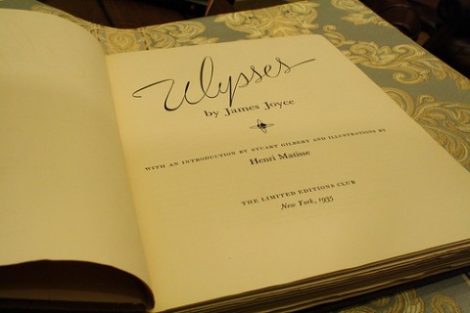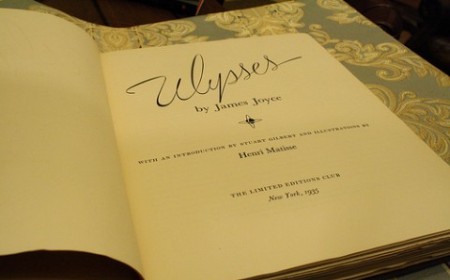
Last year, fans of modernist Irish literature and impressionist art saw a must-own volume go under the hammer at Bonhams. “In 1935 the French artist, Henri Matisse, was commissioned to illustrate an edition of Ulysses for subscribers to the Limited Edition Club in America,” announced Artlyst. “Each of the 1,000 copies was signed by Matisse and 250 were also signed by James Joyce. A copy of the book signed by both men is estimated at £6,000 to £8,000.”
In the event it went for £6,250, not a bad deal considering the hands that wrote those signatures and the rarity, signed or unsigned, of this unusual book itself. (It certainly beats, say, $37,000.) Brainpickings’ Maria Popova writes that, after first spotting the Matisse-illustrated Ulysses here on Open Culture, “I gathered up my year’s worth of lunch money and was able to grab one of the last copies available online — a glorious leather-bound tome with 22-karat gold accents, gilt edges, moire fabric endpapers, and a satin page marker.” (Note: Versions signed by Matisse are apparently available–at a steep price–on Amazon. A less rare edition reissued in 1996 can be acquired as well.)
Popova adds that “the Matisse drawings inside it, of course, are the most priceless of its offerings — doubly so because, for all their beauty, they’re a tragicomedy of quasi-collaboration.” From whence the tragicomedy? Publishing lore has it that, despite the provision of a full French translation of the Ulysses text, Matisse made his illustrative etchings — in the fashion of many an undergraduate with a paper due — without ever having got around to reading the book himself.
“I’ve never ‘read’ Joyce’s Ulysses, and it’s quite plausible that I never will,” Matisse’s countryman Pierre Bayard would write seventy years later in his bestselling How to Talk About Books You Haven’t Read. Yet “I feel perfectly comfortable when Ulyssescomes up in conversation, because I can situate it with relative precision in relation to other books. I know, for example, that it is a retelling of the Odyssey, that its narration takes the form of a stream of consciousness, that its action unfolds in Dublin over the course of a single day, etc.” — all things that Matisse, too, probably knew about Ulysses.
He certainly knew that it supposedly retold the story of the Odyssey, and so, in a now-ingenious-looking strategy to not just talk about an unread book but to illustrate it, he went to the source. Or rather, he went to one of the countless cultural, literary, historical, and linguistic sources upon which Joyce drew to compose his masterpiece, basing his art directly on Homer’s epic poem, in its own way a work more talked about than read. Joyce himself, who once described much of the textual content of Ulysses as intended to “keep the professors busy for centuries arguing over what I meant,” may well have admired Matisse’s clarity of vision, no matter how much-non reading it took to refine.
Source: Open Culture
Vladimir Nabokov Creates a Hand-Drawn Map of James Joyce’s Ulysses
Just above you’ll find a sketched-out map of the paths Stephen Dedalus and Leopold Bloom took through Dublin on June 16, 1904. If you’ve ever read James Joyce’s Ulysses (find it in our lists of Free eBooks and Free Audio Books), you may well have tried drawing one of these yourself, connecting the locations as each chapter finds one of the protagonists somewhere else in Ireland’s capital on that “ordinary” day. Maybe you wanted to test the plausibility of the common assertion that, given accuracy and detail with which Joyce wrote about the city, one could, in case of the apocalypse, build the city all over again using the novel as a plan. This particular Ulysses fan map, however, comes from the hand of a very special reader indeed: Vladimir Nabokov, author of a few much-discussed works of twentieth-century literature himself, including Lolita, Pale Fire, and Speak, Memory.
For those who teach Ulysses, Nabokov has a suggestion: “Instead of perpetuating the pretentious nonsense of Homeric, chromatic, and visceral chapter headings, instructors should prepare maps of Dublin with Bloom’s and Stephen’s intertwining itineraries clearly traced.” A post from Raynor Ganan quotes him as saying that, adding, “Would you not have donated a litre of your own spinal fluid to audit this lecture?” Indeed, Nabokov speaks from experience, having not only produced well-respected literature but taught it, too. The fruits of his time at the front of the classroom appear in his collection Lectures on Literature, though if you want to get as close as possible to the experience of sitting in on one of Nabokov’s classes, go back into our archives and watch the WQED dramatization, starring Christopher Plummer, of his talk on Kafka at Cornell. It won’t give you any insight into Joyce’s Dublin, granted, but some Yale grad students’ more recent project to digitally, interactively map Ulysses just might.
Vladimir Nabokov Creates a Hand-Drawn Map of James Joyce’s Ulysses

